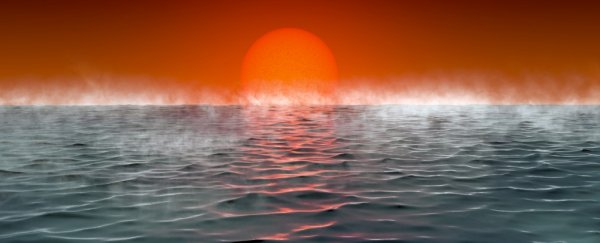When we search for life out there in the galaxy, we base our efforts on what we know. So far, we know only one planet that has yielded life - ours - so we look for Earth-like, rocky worlds at a specific distance range from the host star for livable temperatures.
That doesn't mean life doesn't exist on planets less like Earth, though. Now, a team of astronomers has identified a class of planets that may prove fruitful - exoplanets clad in a global ocean, with atmospheres rich in hydrogen, could host life as we know it.
Such exoplanets are more numerous in planetary surveys than rocky ones, which means they could be fertile territory in the search for alien life. The researchers have dubbed them 'Hycean' worlds.
"Some of the conditions in the oceans of these worlds could be similar to habitable conditions in Earth's oceans, i.e. similar temperatures and pressures, presence of liquid water and energy from the star," astronomer Nikku Madhusudhan from Cambridge University's Institute of Astronomy told ScienceAlert.
"There are many open questions but this is only a first guess at this stage. The assumption is that if microbial aquatic life can form in these oceans in the same manner as they did on Earth then some of the biosignatures may also be common."
To date, nearly 4,500 exoplanets have been identified and confirmed out there, in the wider Milky Way. Data from the Kepler planet-hunting space telescope suggest that the most common type of exoplanet is one that we don't even have in the Solar System - mini-Neptunes, from about 1.6 up to 4 times the radius of Earth.
These are, obviously, smaller than our ice giant Neptune, but above the threshold between rocky planets and gaseous ones. This size and composition results in a thick atmosphere rich in hydrogen, like Neptune, and possibly a liquid ocean beneath it.
Previous research suggested that the pressure on these worlds would be too high to support life as we know it. But last year, Madhusudhan and colleagues published a paper on the mini-Neptune K2-18b. They found a range of conditions under which this world could, in fact, be habitable after all.
Now they've expanded on that previous research, defining the parameters under which mini-Neptunes could support life.
Hycean worlds, Madhusudhan and his team found, can be up to 2.6 times the size of Earth, and up to 10 times Earth's mass. They also have a much larger range of distances from their host star at which life could survive - what we call the habitable zone. Hycean exoplanets can be so close to their star that atmospheric temperatures reach nearly 200 degrees Celsius (nearly 400 degrees Fahrenheit), or at distances at which a rocky planet would be too icy.
"The greenhouse warming due to molecular hydrogen (H2) is such that the planet can be very far from the star and still have warm habitable conditions on the surface," Madhusdhan explained.
"For an Earth-like atmosphere, on the other hand, the main greenhouse gases like H2O and CO2 freeze out at shorter distances, making the surface frozen and not habitable."
Because of this wide habitable zone, there's large variety even within the category of 'Hycean' planets.
Worlds so close to their stars as to be tidally locked, with one side always facing the star, would be classed as 'dark Hycean' exoplanets, where life could only survive on the night side, away from the heat and radiation. 'Cold Hycean' worlds would be those at higher distances, where they would receive relatively little light, warmth and radiation.
The definition of these parameters means that future work can look at the atmospheres of such worlds to try and identify biosignatures – compounds in the atmosphere that could be signs of life.
These include ozone, oxygen and methane, but on Hycean worlds, which don't have as much atmospheric oxygen, other compounds, such as methyl chloride and dimethyl sulphide, could signal the presence of life.
"Essentially, when we've been looking for these various molecular signatures, we have been focusing on planets similar to Earth, which is a reasonable place to start," Madhusudhan said in a press statement.
"But we think Hycean planets offer a better chance of finding several trace biosignatures."
In their paper, the team laid out a few such biomarkers that we might expect to see on Hycean worlds. These can be detected when an exoplanet passes between us and its star, when certain wavelengths of light in the spectrum are boosted or blocked by the atmosphere.
Where these wavelengths fall is a chemical signature that tells us what element or compound causes that effect.
Because mini-Neptunes have such thick atmospheres, this should be easier to accomplish than with the thinner atmospheres of rocky planets. The James Webb Space Telescope, launching later this year, will be able to perform this task very well, but several other instruments that are currently operating would be able to perform scouting observations to establish, for example, the presence of water in a mini-Neptune atmosphere.
Meanwhile, while waiting for telescope time, there is also more theoretical work that needs to be undertaken. But it looks extremely promising.
"This is a fundamentally new avenue in our search for life elsewhere and holds significant promise for detecting life on an exoplanet on a few-year timescale," Madhusudhan told ScienceAlert.
The research has been published in The Astrophysical Journal.
